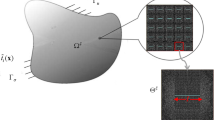Abstract
Fracture analysis of civil engineering structures often requires appropriate modeling of discrete cracks propagating in an inhomogeneous or nonlinear material. For example, quasi-brittle materials, such as concrete, are characterized by formation of cracks with fracture process zone under tension and plasticity under compression. Application of either finite element method (FEM) or boundary element method (BEM) to problems involving simultaneously discrete cracks and inhomogeneities or plastic deformations faces certain difficulties. Therefore, we propose the FEM-BEM superposition method, which removes the respective methods disadvantages while keeping their advantages. In the proposed method, the original problem involving both material inhomogeneity or plasticity and discrete cracks is decomposed into two subproblems. The inhomogeneity or inelastic deformation is represented in only one of the subproblems, while the cracks appear only in the other. The former subproblem is analyzed using FEM and the latter one by BEM, so as to utilize the advantages of the two methods. The solution of the original problem is then obtained by superposing the solutions of the two subproblems. In order to verify validity of the proposed method we present numerical results of several examples, including both linear-elastic and nonlinear fracture mechanics. The results are compared with available analytical solutions or with data computed by other numerical methods, showing both accuracy and computational superiority of the proposed method.
Similar content being viewed by others
References
Annigeri, B.S. and Cleary, M.P. (1984). Surface integral finite element hybrid (SIFEH) method for fracture mechanics. International Journal for Numerical Methods in Engineering 20, 869-885.
Barlow, J. (1976). Optimal stress locations in finite element models. International Journal for Numerical Methods in Engineering 10, 243-251.
Bažant, Z.P. and Oh, B.H. (1983). Crack band theory for fracture of concrete. Materials and Structures 16, 93, 155-177.
Belytschko, T. and Lu, Y.Y. (1994). A variationally coupled FE-BE method for transient problems. International Journal for Numerical Methods in Engineering 37, 91-105.
Brebbia, C.A. (1984). The Boundary Element Method for Engineers. Pentech Press.
Červenka, J. (1994). Discrete crack modeling in concrete structures. Ph.D. Thesis, University of Colorado, Boulder.
Chen, W.F. (1994). Constitutive Equations for Engineering Materials. Elsevier.
Crouch, S.L. (1976). Solution of plane elasticity problems by the displacement discontinuity method. International Journal for Numerical Methods in Engineering 10, 301-343.
Hillerborg, A., Modéer, M. and Petersson, P.-E. (1976). Analysis of crack formation and crack growth in concrete by means of fracture mechanics and finite elements. Cement and Concrete Research 6, 773-782.
Horii, H. (1988). BIEM for crack problems and application to fracture process zone in concrete, ceramics and rock. (Edited by M. Tanaka and T.A. Cruse). Boundary Element Methods in Applied Mechanics. Pergamon Press, 129-138.
Jirásek, M. (1998). Comparative study on finite elements with embedded cracks. Submitted to Computer Methods in Applied Mechanics and Engineering.
Keat, W.D., Annigeri, B.S. and Cleary, M.P. (1988). Surface integral and finite element hybrid method for two-and three-dimensional fracture mechanics analysis. International Journal of Fracture 36, 35-53.
La Mendola, L. (1997). Cracking analysis of RC members by using coupled BE-FE modeling. Journal of Engineering Mechanics 123(7), 758-761.
Murakami, Y. (ed.-in-chief) (1987). Stress Intensity Factors Handbook, Pergamon Press.
Nanakorn, P. and Horii, H. (1995). A finite element with embedded displacement discontinuity. (Edited by Y.C. Loo). Building for the 21st Century. Griffith University, Gold Coast Campus, 33-38.
Owen, D.R.J. and Hinton, E. (1980). Finite Elements in Plasticity: Theory and Practice. Pineridge Press Ltd.
Rots, J.G. (1989). Stress rotation and stress locking in smeared analysis of separation. (Edited by Mihashi et al.). Fracture Toughness and Fracture Energy. Balkema, Rotterdam, 367-382.
Shah, S.P., Swartz, S.E. and Wang, M.L. (1990). Micromechanics of Failure of Quasi-Brittle Materials. Elsevier Applied Science.
Snyder, M.D. and Cruse, T.A. (1975). Boundary-integral equation analysis of cracked anisotropic plates. International Journal of Fracture 11, 315-328.
Stoer, J. and Bulirsch, R. (1980). Introduction to Numerical Analysis. Springer-Verlag.
Wang, Y.B. (1993). A new boundary integral equation method of three-dimensional crack analysis. International Journal of Fracture 63, 317-328.
Wang, Y.B. and Chau, K.T. (1997). A new boundary element for plane elastic problems involving cracks and holes. International Journal of Fracture 87, 1-20.
Weaver, J. (1977). Three-dimensional crack analysis. International Journal of Solids and Structures 13, 321-330.
Wium, D.J.W., Buyukozturk, O. and Li, V.C. (1984). Hybrid model for discrete cracks in concrete. Journal of Engineering Mechanics 110(8), 1211-1229.
Xu, G. and Ortiz, M. (1993). A variational boundary integral method for the analysis of three-dimensional cracks of arbitrary geometry modelled as continuous distributions of dislocation loops. International Journal for Numerical Methods in Engineering 36, 3675-3701.
Zienkiewicz, O.C. and Taylor, R.L. (1989). The Finite Element Method, Vol. 1. McGraw-Hill.
Zienkiewicz, O.C. and Taylor, R.L. (1991). The Finite Element Method, Vol. 2. McGraw-Hill.
Author information
Authors and Affiliations
Rights and permissions
About this article
Cite this article
Kabele, P., Yamaguchi, E. & Horii, H. FEM-BEM superposition method for fracture analysis of quasi-brittle structures. International Journal of Fracture 100, 249–274 (1999). https://doi.org/10.1023/A:1018714717261
Issue Date:
DOI: https://doi.org/10.1023/A:1018714717261




